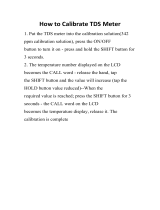
Table of Contents
1. INTRODUCTION ....................................................................... 1
2. GETTING STARTED.................................................................. 2
2.1 Description of Keypad Functions .................................................................2
2.2 Description of LCD Annunciators .................................................................3
2.3 Inserting & Removing the Rubber Armour / Stand .......................................4
2.4 Inserting New Batteries ...............................................................................4
2.5 Battery Replacement ...................................................................................5
2.6 Electrode Information ..................................................................................5
2.7 Connecting the Electrode ............................................................................6
2.8 Switching the Meter On ...............................................................................7
2.9 Changing Mode ...........................................................................................8
3. CALIBRATION ........................................................................... 9
3.1 Important Information on Meter Calibration .................................................9
3.2 Preparing the Meter for Calibration ..............................................................10
3.3 Selection of Auto or Manual Calibration (COND 6+) ....................................10
3.4 Using Automatic Calibration (COND 6+)......................................................11
3.5 Manual Calibration ......................................................................................13
3.6 Temperature Calibration ..............................................................................14
4. MEASUREMENT ....................................................................... 15
4.1 With Automatic Temperature Compensation (ATC) .....................................15
4.2 Without ATC (Manual Temperature Compensation) ....................................15
4.3 Taking Measurements .................................................................................16
4.4 Using Manual Ranging Function (COND 6+, TDS 6+) .................................16
4.5 HOLD Function............................................................................................18
5. ADVANCED SETUP FUNCTIONS ............................................ 18
5.1 Advanced Setup Overview ..........................................................................18
5.2 Select Cell Constant (COND 6+, TDS 6+ only) ............................................20
5.3 Automatic Calibration (COND 6+ only) ........................................................20
5.4 Setting the TDS Factor (TDS 6+ only) .........................................................21
5.5 Temperature Coefficient ..............................................................................21
5.6 Normalization Temperature .........................................................................22
5.7 Single-Point Calibration (COND 6+, TDS 6+ only) .......................................22
5.8 Restore Factory Default Values ...................................................................23
6. PROBE CARE AND MAINTENANCE ....................................... 23
7. TROUBLESHOOTING ............................................................... 24
8. SPECIFICATIONS / FEATURES ............................................... 25
9. CONDUCTIVITY THEORY ......................................................... 27






















